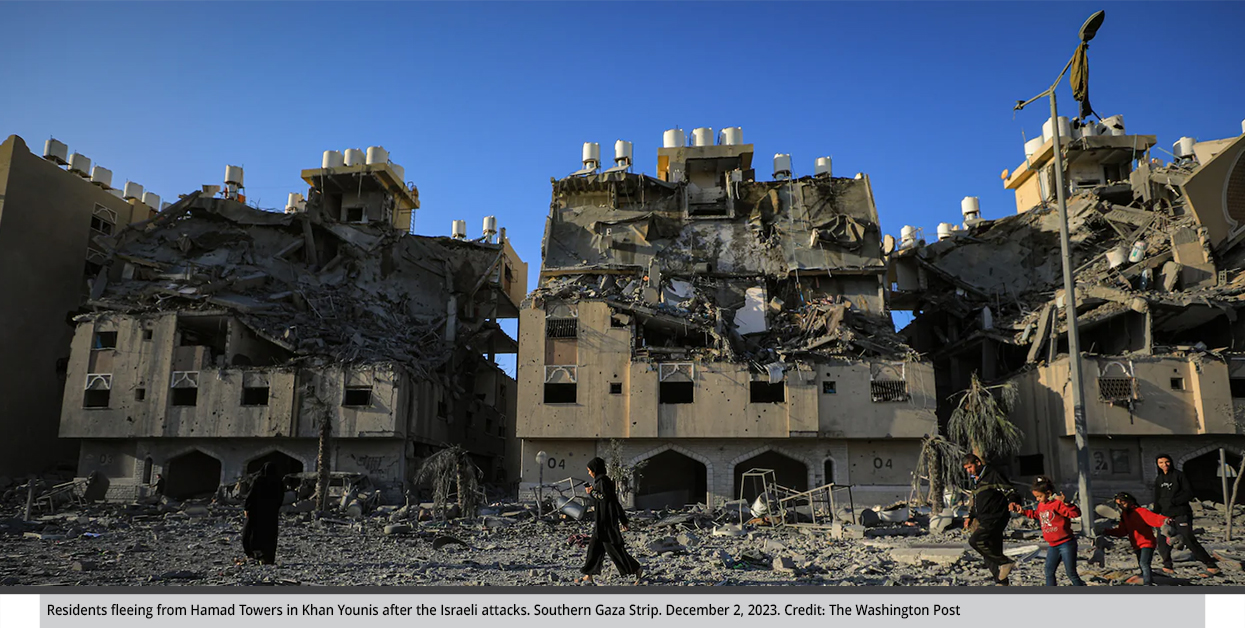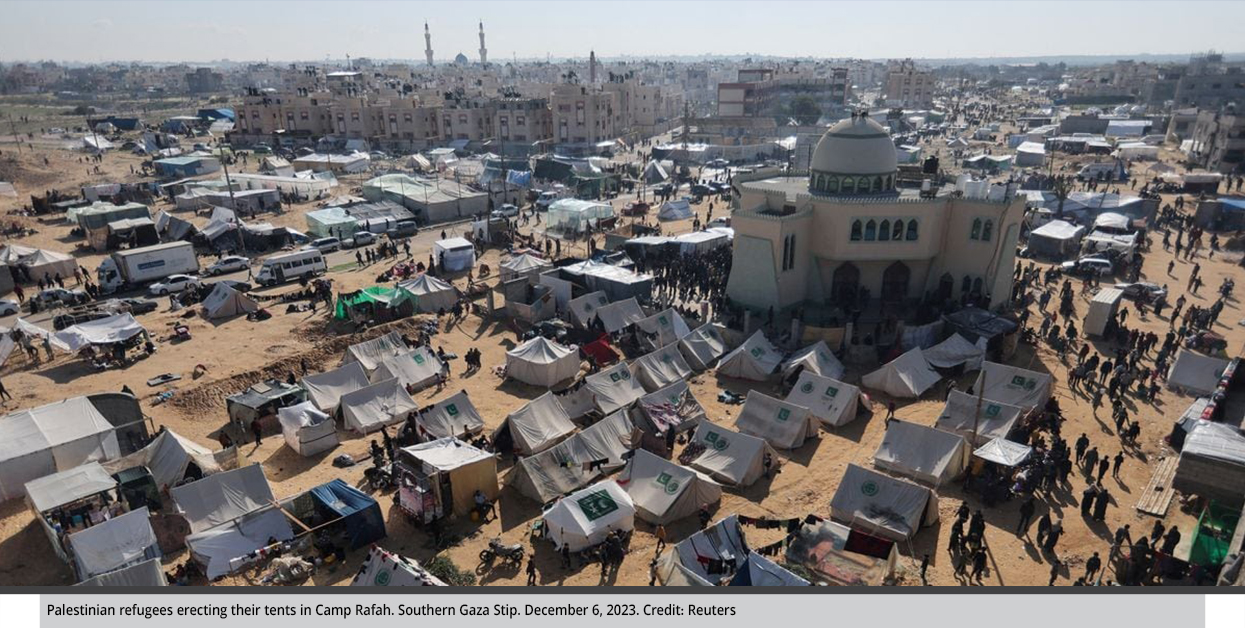Gaza War: Complex Considerations, Elusive Truce, and No End in Sight
The war in Gaza has reached a critical juncture, intensifying in a way that concerns mediators and neighboring countries, with implications for the broader international community. This escalation is evident in negotiations for a possible new truce, where the demands and priorities of the parties involved, along with the complex considerations of the mediators, are prominently featured. These intricate dynamics have led to multiple parallel tracks for both the war and the truce efforts, which this paper aims to explore.
by Hazem Salem Dmour
- Release Date – Feb 11, 2024

The war in the Gaza Strip has seen intensified statements regarding indirect negotiations between Hamas and Israel facilitated by the tripartite mediation of Qatar, Egypt, and America that aims for a potential new long-term truce that could come into effect at any time. Hamas has responded to the framework agreement drafted by the three mediators, alongside Israeli security officials, in Paris on January 28.
The Qatari Foreign Ministry described the agreement as “positive.” However, Israel’s rejection of many of Hamas’s demands and the upcoming visit of CIA Director William Burns to Egypt both underscore the complexities inherent in the truce’s details. These complexities are particularly apparent in the conflicting priorities of the warring sides and the nuanced considerations of the mediators that put both the war and the truce on multiple tracks.
Contradicting Priorities of Hamas and Israel
In the fourth month of a war with multiple losses and regional complexities, the region entered a deeper state of uncertainty, both in terms of the date the war will end and how it will end, in addition to the possibility that the conflict may spill over into the region and that the repercussions of the war may affect countries that either view the war as the start of an open conflict or believe that the end of the war will reduce tensions and the chance of escalation. This is clearly reflected in the new truce negotiations and is demonstrated in the demands and priorities of both sides.
For Israel, popular and international pressure is increasing on both its government and the War Council to give the highest priority to both the release of the hostages held by Palestinian factions and the alleviation of humanitarian suffering in the Gaza Strip. Meanwhile, there is an agreement between the Israeli government and the U.S. administration to continue the war until it achieves its goals, specifically undermining the ability of Hamas to threaten Israel or the administrating Gaza.
Therefore, we find that the Israeli vision in the framework agreement focused on the issues of Israeli hostages and humanitarian aid through a three-stage truce, while more complex issues such as the ceasefire, reconstruction, and lifting of the siege will be discussed during the truce. This is reflected in the framework agreement:
- In the first phase (45 days), Hamas will release all hostages, including women, children, sick men, and the elderly. In return, Israel will release a limited number of Palestinian prisoners who were not sentenced for major crimes; allow more aid to enter the Gaza Strip; allow hospital reconstruction work to begin; execute a partial withdrawal of Israeli forces; allow the return of displaced persons to Gaza and the northern Gaza Strip; and start indirect talks on the requirements for restoring calm.
- The second phase will negotiate Hamas releasing captured Israeli soldiers and officers in exchange for Israel releasing a number of Palestinian prisoners.
- The third phase includes both sides releasing corpses in their possession, holding an agreement on crossings, and the reconstruction of the Gaza Strip.
As for Hamas, the priority in any truce is no longer the demands for which the October 7 attacks were carried out, represented in “emptying the Israeli prisons” and halting Israeli violations of Al-Aqsa Mosque, as much as Hamas priorities now have become the return in the Gaza Strip to the pre-war situation, especially with regard to the withdrawal of the Israeli army from its areas of deployment in the north, center, and south; the return of the displaced to their areas; the preservation of the territorial integrity of Gaza; and a sustainable ceasefire.
The adoption of these files may represent a strategic loss for Hamas, especially if it releases all Israeli prisoners under its custody without stopping the war. This may prompt Hamas in the future to surrender its political and military assets in exchange for a ceasefire. This was evident in Hamas’s response to the draft agreement, which included the following demands:
- the entry of at least 600 trucks per day of aid and fuel, as well as tents and shelters, during the first phase and the return of displaced people to the north and south of the Gaza Strip;
- Hamas’s approval of any plan for the reconstruction of the Gaza Strip for a maximum period of three years; and,
- ending the siege with a full and sustainable truce, in addition to expanding the guarantors for the implementation of the agreement, as suggested by Turkey and Russia.

Complicated Considerations for the Guarantors
Hamas’s addition of two new states to guarantee the agreement—Turkey at the regional level and Russia at the international level—is mainly due to Hamas’s awareness of the extreme sensitivities as well as the complex and multiple considerations of the current mediators: Egypt, Qatar, and the United States, each of which is engaging in negotiations influenced by domestic and foreign factors.
For instance, the United States is supporting the continuation of the war while also seeking to establish a truce that allows the release of prisoners held by Palestinian factions and more humanitarian aid to enter the Gaza Strip. It is attempting to direct the truce negotiations towards establishing future arrangements for the Gaza Strip that recognizes the proposed Palestinian state within the two-state solution (which the Israeli government rejects).
This strategy will allow U.S. President Joe Biden to present political achievements that support him in his re-election campaign, especially in light of his opponent Donald Trump’s success in the primaries. It also helps alleviate his administration’s embarrassing position before the international community and allied Arab countries of wholeheartedly supporting Israel in the war.
In addition, the truce may constitute a leverage to the Saudi-Israeli normalization project, which was among Biden’s electoral promises in his first presidential campaign. A recent statement by the Saudi Foreign Ministry confirmed that there will be no peace with Israel without a Palestinian state with East Jerusalem as its capital.
On the other hand, the regional escalation that Washington has feared since the outbreak of the war, and Washington involvement in a wider conflict or clash, are more immanent than ever, especially after Iran’s allies intensified their attacks against U.S. naval and land forces in the region. One of these attacks, conducted in late January by the Islamic Resistance in Iraq, killed three U.S. soldiers at Tower 22, a U.S. military outpost in Rukban, Jordan, which is near the Syrian border. In addition, there have been Houthi attempts to target U.S. warships in the Red Sea with anti-ship missiles, the first time that the U.S. Navy has been targeted in the Red Sea.
As for Egypt, it is pressuring the warring sides to accept the truce. Egypt’s concern is that the war may force the 1.3 million residents and displaced Palestinians currently residing in the Palestinian city of Rafah—which staddles the Egypt-Gaza Strip border—to escape towards the Egyptian Sinai. This concern prompted Egypt to invite a Hamas leadership delegation to Cairo on February 8 to discuss a possible truce. Meanwhile, Egypt proceeds in its position against the Israeli government’s determination to intensify the war via military operations in the Rafah border area that includes Israeli warplanes launching a series of raids and fire belts in Rafah. On February 7, Israeli Defense Minister Yoav Galant confirmed the army’s plans to expand operations and combat in the last significant area, which is Rafah, despite escalating international warnings to Israel against its invasion.

As for Qatar, it is facing Israeli allegations of leniency towards Hamas. An audio leak broadcast by Israeli television’s Channel 12 on January 23 captured Israeli Prime Minister Benjamin Netanyahu describing the Qatari role as “problematic.” Doha immediately denounced Netanyahu’s statements, with Qatari Foreign Ministry spokesman Majed Al-Ansari commenting, “Instead of being preoccupied with Qatar’s strategic relationship with the United States, we hope that Netanyahu will be busy working to overcome obstacles to reaching an agreement to release the hostages.”
In fact, part of the statements exchanged between Qatar and Israel can be attributed to the opposition of right-wing parties in the Israeli government against Doha hosting Hamas leaders, especially the head of the Hamas political bureau, Ismail Haniyeh. Netanyahu declared January 27 that “Qatar hosts and even finances Hamas leaders.”
Potential Tracks of the Truce
In light of the complexity and intertwining of the priorities held by both sides in the war, as well as the considerations of the mediators, it is very difficult to predict that a possible truce may be applied—or even what nature this truce will be or how it may be implanted. The possibilities remain open on more than one of the following tracks:
Track One: Negotiations Stall
Indirect negotiations between the two sides of the war began recently with Hamas sending its response to the framework agreement, which underscored the wide gaps between its demands and those of Israeli. This prompted Israeli Defense Minister Yoav Galant to say that Hamas’s response was “formulated in such a way that led Israel to reject it.” In fact, the negotiations between Hamas and Israel face a complex set of challenges, including the continued threat of each side to decisively win on the ground and the need for each side to carry on the war until achieving their own goals, especially after the losses incurred and the gains achieved. Thus, it became difficult for either side to sacrifice its gains by agreeing to a truce.
Due to the fundamental disparity in priorities, what tops the list for one side is, ipso facto, completely rejected by the other side. Therefore, the potential truce is likely to stall—even if the mediators reach an agreement. The continuation of the war would relate any future truces to new facts on the ground, so that the mediators need a new negotiating framework.
Track Two: Successful Negotiations Towards a Permanent Truce
A breakthrough in the demands of the Arab mediators and Hamas to achieve a truce with a sustainable ceasefire is possible and real. This is particularly true if the mediators increase their pressure on both Hamas and Israel to abandon some of their demands, especially Hamas’s main demands for the withdrawal of Israeli forces or determining a timetable for reconstruction. This last point is a very complex one, in terms of expanding the actors in the negotiations to include donor countries since reconstruction will require a long-term framework that may take years to negotiate.
Israel and the United States relate reconstruction to its overseers, as well as to the advent of a new administration in the Gaza Strip. On the other hand, there is U.S. pressure on Israel to engage in arrangements for the final solution of the Palestinian cause, which Washington links to negotiations and seeks to impose on Hamas in exchange for the rehabilitation of the Gaza Strip and the withdrawal of the Israeli army from it. Hence, any truce, including a sustainable ceasefire, will be accompanied by arduous negotiations for the establishment of a Palestinian state within the two-state solution.
Track Three: Reaching a Temporary Truce
The warring sides’ strict priorities of a long-term truce could turn it into a temporary truce, during which the general principles may be applied in the first phase of the framework agreement: the Israeli hostages would be partially released while retaining a number of military prisoners held by Palestinian factions in exchange for releasing a number of other Palestinian prisoners in Israeli prisons and the entry of humanitarian aid.
In conclusion, the chances of track two succeeding seems to be the lowest compared to tracks one and three, especially after Netanyahu announced on February 8 his rejection of Hamas’s demands and his determination to completely eliminate Hamas, directing the Israeli army to “work in Rafah” while “opening a safe passage for the population.” This increases the chances of track one succeeding, especially in the military strategy adopted by Netanyahu and army leaders that intensifying military pressure will push Hamas to surrender and accept the Israeli conditions. This would put forward the possibility of a truce based on new Israeli provisions.
However, this does not mean that the chances of track three succeeding are nil. Perhaps the last Israeli position may be a way for track three to prevent the repercussions of an Israeli ground attack on Rafah, with mediators working on the issue, in exchange for Hamas making new concessions. This possibility explains the quick announcement of a Hamas delegation headed by Khalil al-Hayya, deputy head of the movement in Gaza, concerning continuing ceasefire talks with Egyptian and Qatari officials.

Hazem Salem Dmour
General Manager / Specialized Researcher in International Relations and Strategic Studies
 العربية
العربية